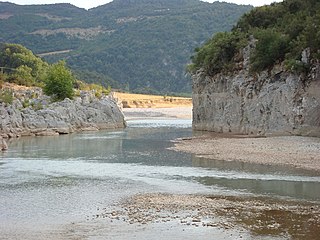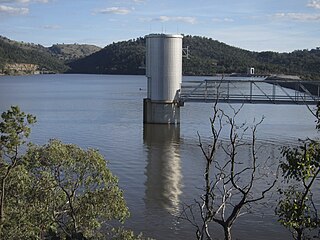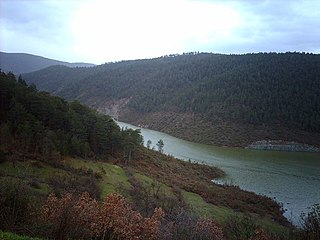
Hydroelectricity, or hydroelectric power, is electricity produced from hydropower. In 2020 hydropower generated one sixth of the world's electricity, almost 4500 TWh, which was more than all other renewables combined and also more than nuclear power.

The Achelous, also Acheloos, is a river in western Greece. It is 220 km (137 mi) long. It formed the boundary between Acarnania and Aetolia of antiquity. It empties into the Ionian Sea. In ancient times its spirit was venerated as the river god Achelous.

With a height of 260.5 m Tehri Dam is the tallest dam in India. It is currently ranked No 10 on the List of Tallest Dams in the world. With a total planned installed capacity of 2400 MW, it's the biggest Hydroelectric power plant in India. It is a multi-purpose rock and earth-fill embankment dam on the Bhagirathi River in New Tehri, Tehri Garhwal district in Uttarakhand, India. It is the primary dam of the THDC India Ltd. and the Tehri hydroelectric complex. Phase 1 was completed in 2006. The Tehri Dam withholds a reservoir for irrigation, municipal water supply and the generation of 1,000 megawatts (1,300,000 hp) of hydroelectricity. The dam's 1,000 MW variable-speed pumped-storage scheme is currently under construction with expected commissioning in 2025.

Wyangala Dam is a major gated rock fill with clay core embankment and gravity dam with eight radial gates and a concrete chute spillway across the Lachlan River, located in the south-western slopes region of New South Wales, Australia. The dam's purpose includes flood mitigation, hydro-power, irrigation, water supply and conservation. The impounded reservoir is called Lake Wyangala.

The Nurek Dam is an earth-fill embankment dam on the Vakhsh River in Tajikistan. Its primary purpose is hydroelectric power generation and its power station has an installed capacity of 3,015 MW. Construction of the dam began in 1961 and the power station's first generator was commissioned in 1972. The last generator was commissioned in 1979 and the entire project was completed in 1980 when Tajikistan was still a republic within the Soviet Union, becoming the tallest dam in the world at the time. At 300 m (984 ft), it is currently the second tallest man-made dam in the world, after being surpassed by Jinping-I Dam in 2013. The Rogun Dam, also along the Vakhsh in Tajikistan, may exceed it in size when completed.

Tarbela Dam is an earth-filled dam along the Indus River in Pakistan's Khyber Pakhtunkhwa province. Located mainly in the Haripur District of the province, The dam is about 30 km (20 mi) from the city of Swabi, 105 km (65 mi) northwest of Islamabad, and 125 km (80 mi) east of Peshawar. It is the largest earth-filled dam in the world. The dam is 143 metres (470 ft) high above the riverbed and its reservoir, Tarbela Lake, has a surface area of approximately 250 square kilometres (97 sq mi).

A reservoir is most commonly an enlarged natural or artificial lake created using a dam to store fresh water.

The Stratos Hydroelectric Dam is a dam on the river Acheloos in Aetolia-Acarnania, western Greece. It is situated just east of the village Stratos, and 9 km northwest of Agrinio. The dam created the Stratos artificial lake. There are four more dams upstream from the Stratos Dam: the Kastraki Dam, the Kremasta Dam, the Sykia Dam and the Mesochora Dam.

The Boguchany Dam is a large hydroelectric dam on the Angara River in Kodinsk, Krasnoyarsk Krai, Russia. It has an installed capacity of 2,997 MW. Construction of the power plant was completed when a ninth and final generator was brought online in January 2015.

Çınarcık Dam is a rock-fill dam on the Orhaneli River about 30 km (19 mi) east of Mustafakemalpaşa in Bursa Province, Turkey. It serves several purposes to include power, irrigation, flood control and municipal water supply to the city of Bursa. The dam was constructed between 1996 and 2002. Construction of the Uluabat Hydroelectric Station, which the dam supplies water to, began in 2006 and it was commissioned in 2010. The 125 m (410 ft) tall dam diverts water north through an 11.27 km (7.00 mi) long tunnel where it reaches the power station on the southern bank of Lake Uluabat. Water discharged from the 100 MW power station then enters the lake. The dam and power station are owned by the Turkish State Hydraulic Works.
The Jinping-I Dam also known as the Jinping-I Hydropower Station or Jinping 1st Cascade, is a tall arch dam on the Jinping Bend of the Yalong River in Liangshan, Sichuan, China. Construction on the project began in 2005 and was completed in 2014. Its power station has a 3,600 MW capacity to produce between 16 and 18 TW·h annually. Supplying the power station is a reservoir created by the 305-meter-tall arch dam, the tallest in the world. The project's objective is to supply energy for expanding industrialization and urbanization, improve flood protection, and prevent erosion.

The Linth–Limmern Power Stations are a system of hydroelectric power stations located south of Linthal in the canton of Glarus, Switzerland. The system uses five reservoirs and four power stations at steep variations in altitude.

Vacha Reservoir is a body of water associated with a dam in Devin Municipality, south Bulgaria. It is part of the Vacha Cascade Joint Implementation Project involving three more dams and four power stations. The three other existing dams on the Vacha River are the Krichim Dam, the Tsankov Kamak Dam and the Teshel Dam.
The Sykia Dam is a mostly constructed but unused earth-filled embankment dam on the Acheloos River along the border of Karditsa and Arta, Greece. The 170 m (560 ft) tall dam is part of the Acheloos River Diversion which is intended to divert a portion of the Acheloos west to irrigate 240,000–380,000 ha in the Thessaly plains. The project includes the Sykia, Messochora, Mouzaki and Pyli Dams along with a 17.4 km (10.8 mi) long channel.

The Mesochora Dam is concrete-face rock-fill dam on the Acheloos River near Mesochora in Trikala, Greece. The 150 m (490 ft) tall dam is part of the Acheloos River Diversion which is intended to divert a portion of the Acheloos west to irrigate 240,000–380,000 ha in the Thessaly plains. The project includes the Mesochora, Sykia, Mouzaki and Pyli Dams along with a 17.4 km (10.8 mi) long channel.

The Kastraki Dam is an earth-fill embankment dam on the Achelous River near the village of Kastraki in Aitoloakarnania, Greece. It was completed in 1969 for the purposes of hydroelectric power generator, flood control and irrigation. The dam's power station houses four 80 MW Francis turbine-generators for an installed capacity of 320 MW. In 2010 the dam's overflow chute spillway was upgraded with 20 fuse plugs which increased the maximum height of the reservoir by 1.93 m (6.3 ft) and its storage capacity by 44,000,000 m3 (36,000 acre⋅ft).
The Daryan Dam, also spelled Darian, is an embankment dam constructed on the Sirvan River just north of Daryan in Paveh County, Kermanshah Province, Iran. The primary purpose of the dam is to supply up to 1,378,000,000 m3 (1,117,000 acre⋅ft) of water annually to the 48 km (30 mi) long Nowsud Water Conveyance Tunnel where it will irrigate areas of Southwestern Iran. The dam also has a 210 MW hydroelectric power station. Construction on the dam began in 2009 and the dam began to fill its reservoir in late November 2015. The Darian Dam Archaeological Salvage Program (DDASP) was planned by Iranian Center for Archaeological Research before flooding the reservoir. As a result a number of important archaeological sites were discovered and some were excavated. The power station was commissioned in 2018. The dam's diversion tunnel was completed in June 2011. The dam was designed by Stucky of France and consultation was provided by Mahab Ghodss, International Consulting Engineering Co. In August 2010 Farab Co. won the contract to build the power station. In 2011, workers on the project held a protest against unpaid wages. The dam is also the subject of protest due to the forced relocations and ecological/cultural impact its reservoir will have.
The Yedigöze Dam, also known as Sani Bey Dam, is a concrete-face rock-fill dam on the Seyhan River bordering İmamoğlu and Aladağ districts in Adana Province, Turkey. The primary purpose of the dam is hydroelectric power generation and irrigation. The dam's power station has an installed capacity of 320 MW and the reservoir will help irrigate 75,000 ha. Construction began in 2007 and the river was diverted by 2008. In the same year construction on the actual dam began and the reservoir began to fill on 15 June 2010. By November 2010 the remaining construction work was complete and the generators were commissioned in 2011. Construction on the irrigation works is ongoing.

Ethiopia generates most of its electricity from renewable energy, mainly hydropower.
The Lianhua Dam is a concrete-face rock-fill dam on the Mudan River in Linkou County of Heilongjiang Province, China. It is located about 95 km (59 mi) north of Mudanjiang. The 71.8 m (236 ft) tall dam serves several purposes to include hydroelectric power generation, flood control and water supply for irrigation. The dam withholds a large 4,180,000,000 m3 (3,390,000 acre⋅ft) capacity reservoir and supports a 550 MW power station. Construction on the dam began in November 1992 and its first 137.5 MW Francis turbine-generator was operational in December 1996. Two more generators were commissioned on 12 December 1997 and the remaining generator was commissioned on 28 September 1998. It is the first large modern water conservancy project in Heilongjiang. The dam's reservoir displaced 40,000 people and will serve as the lower reservoir for the Huanggou Pumped Storage Power Station when it is complete.
















